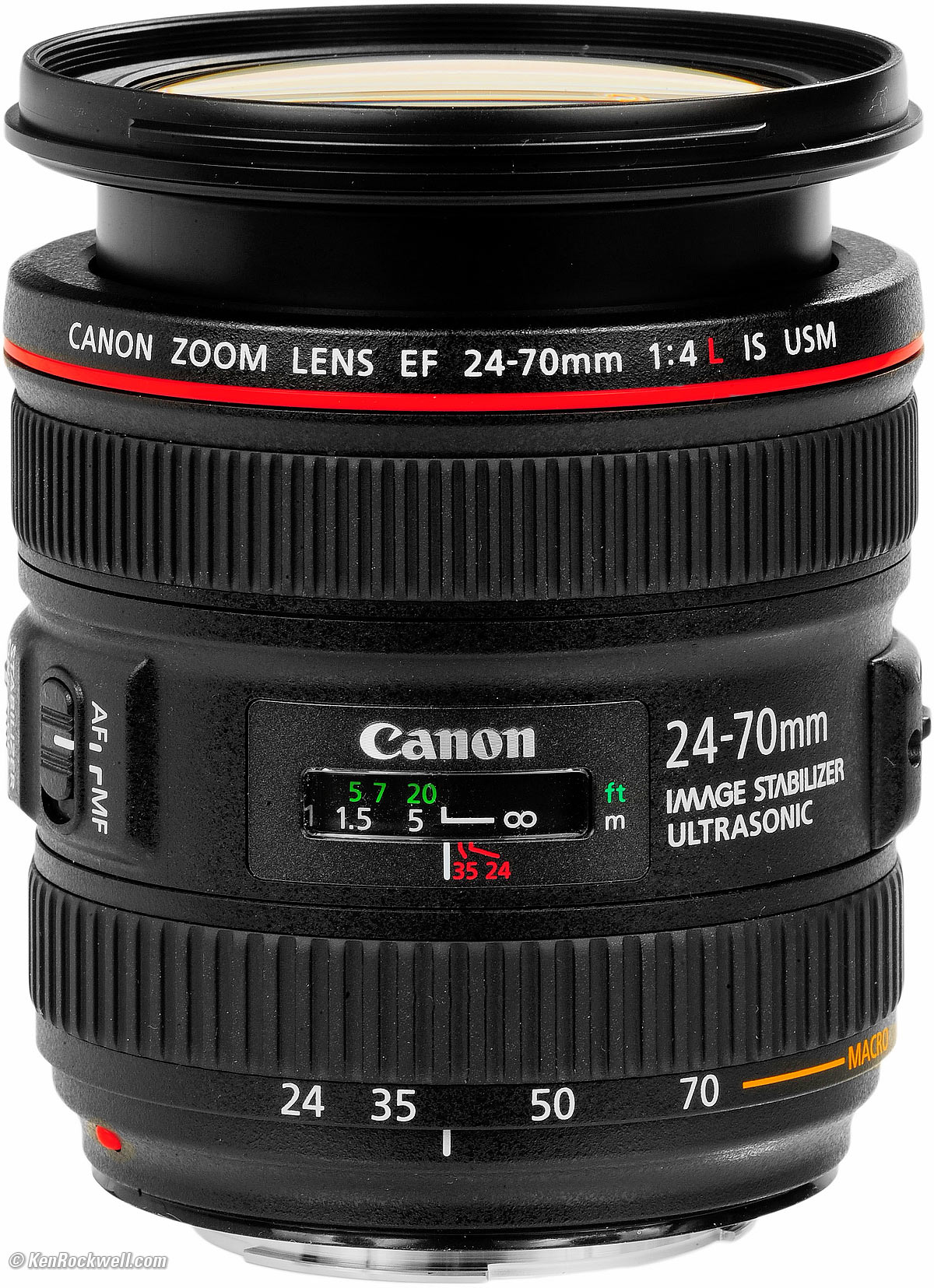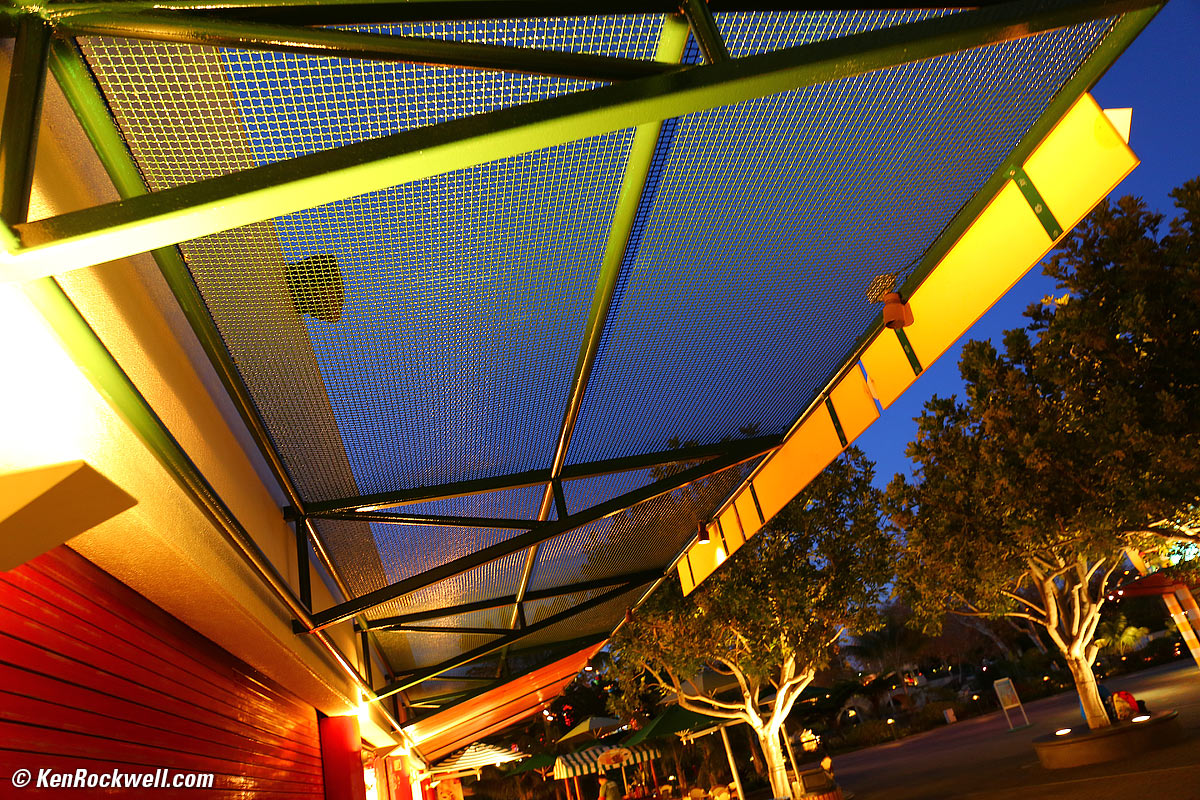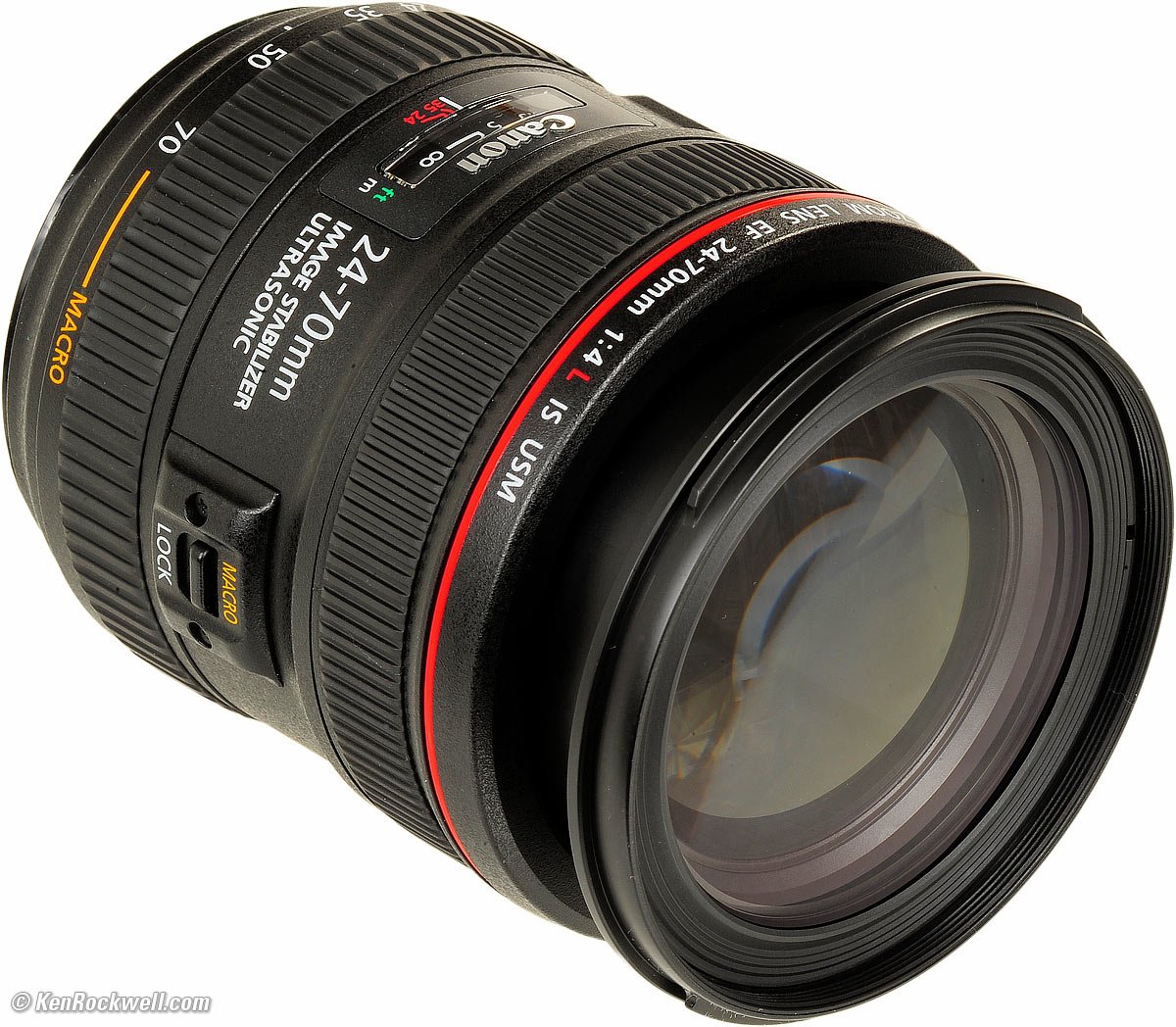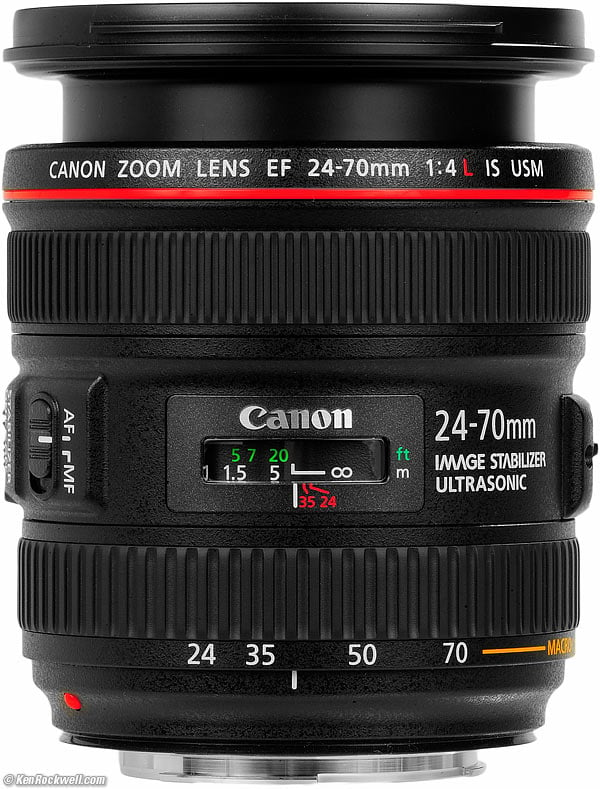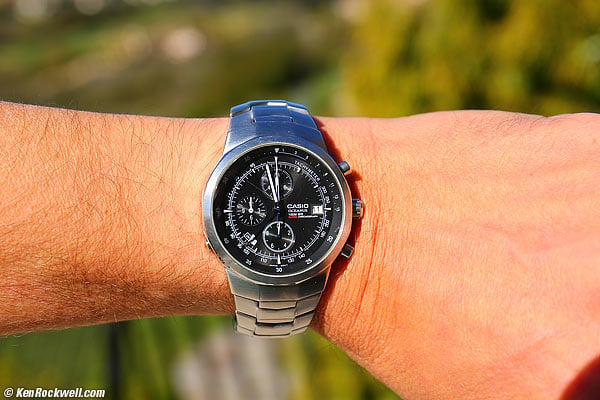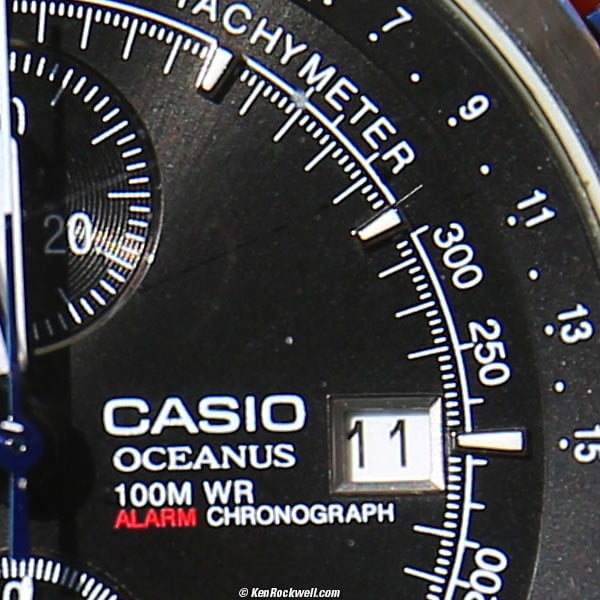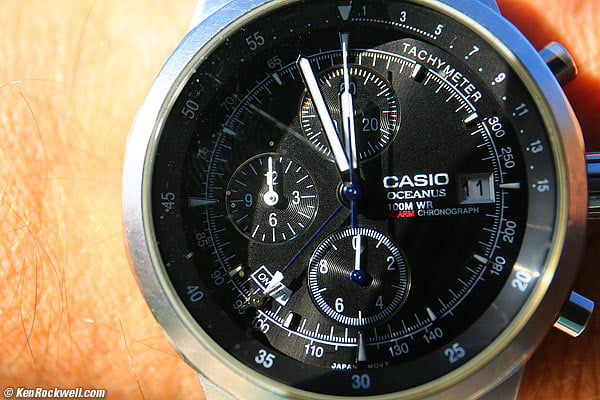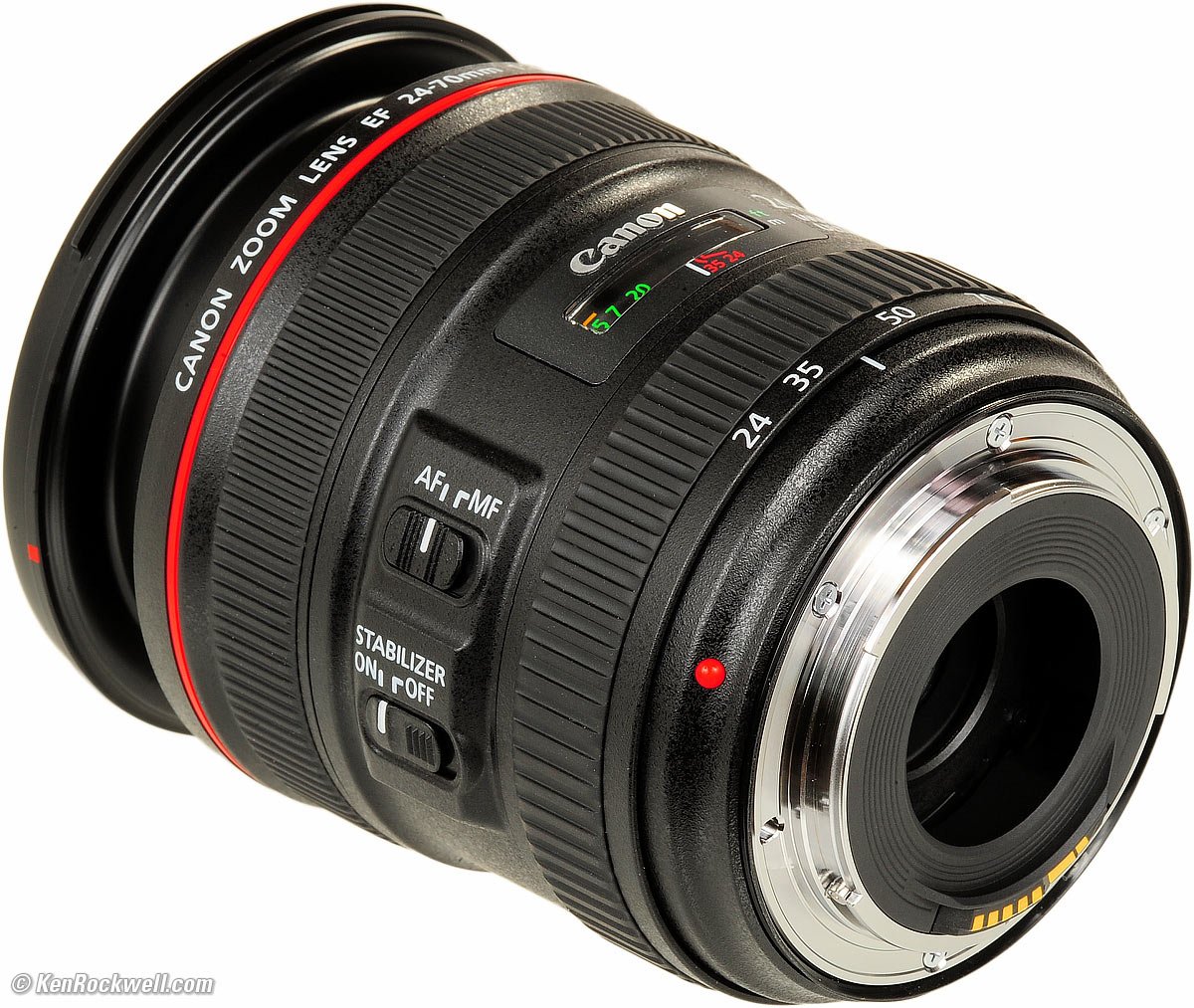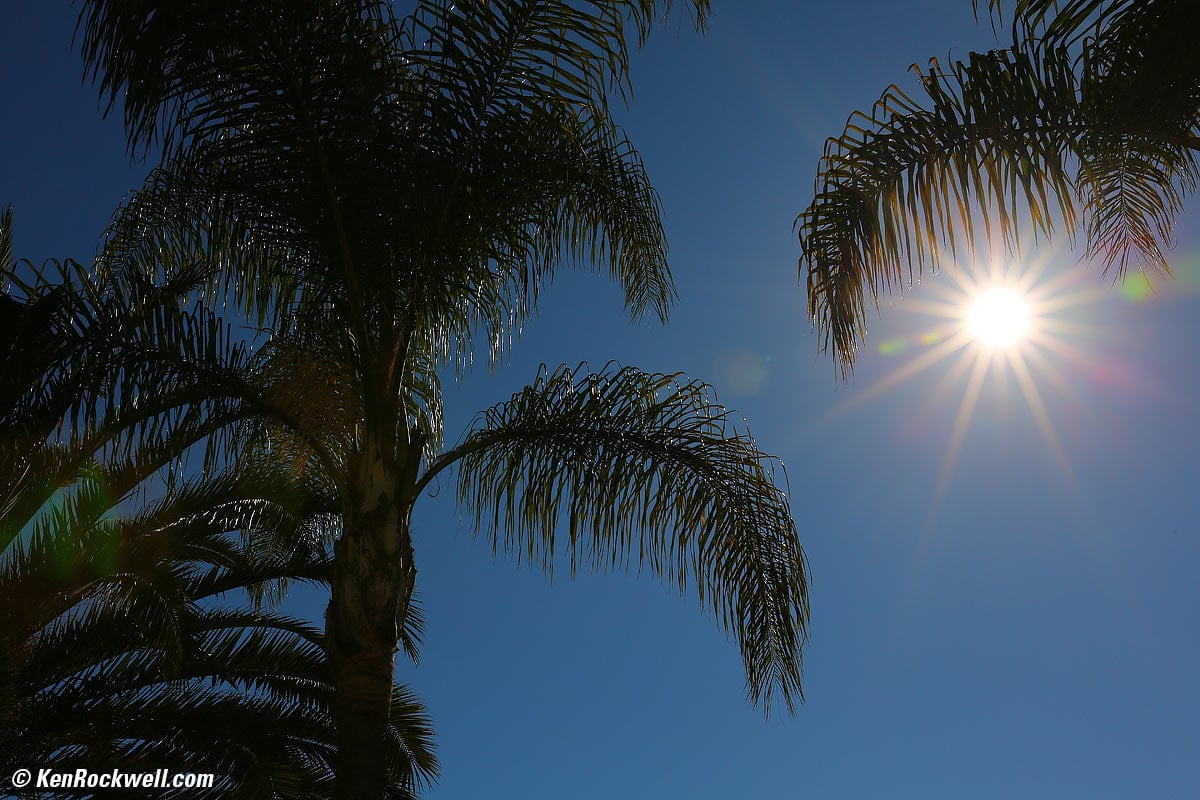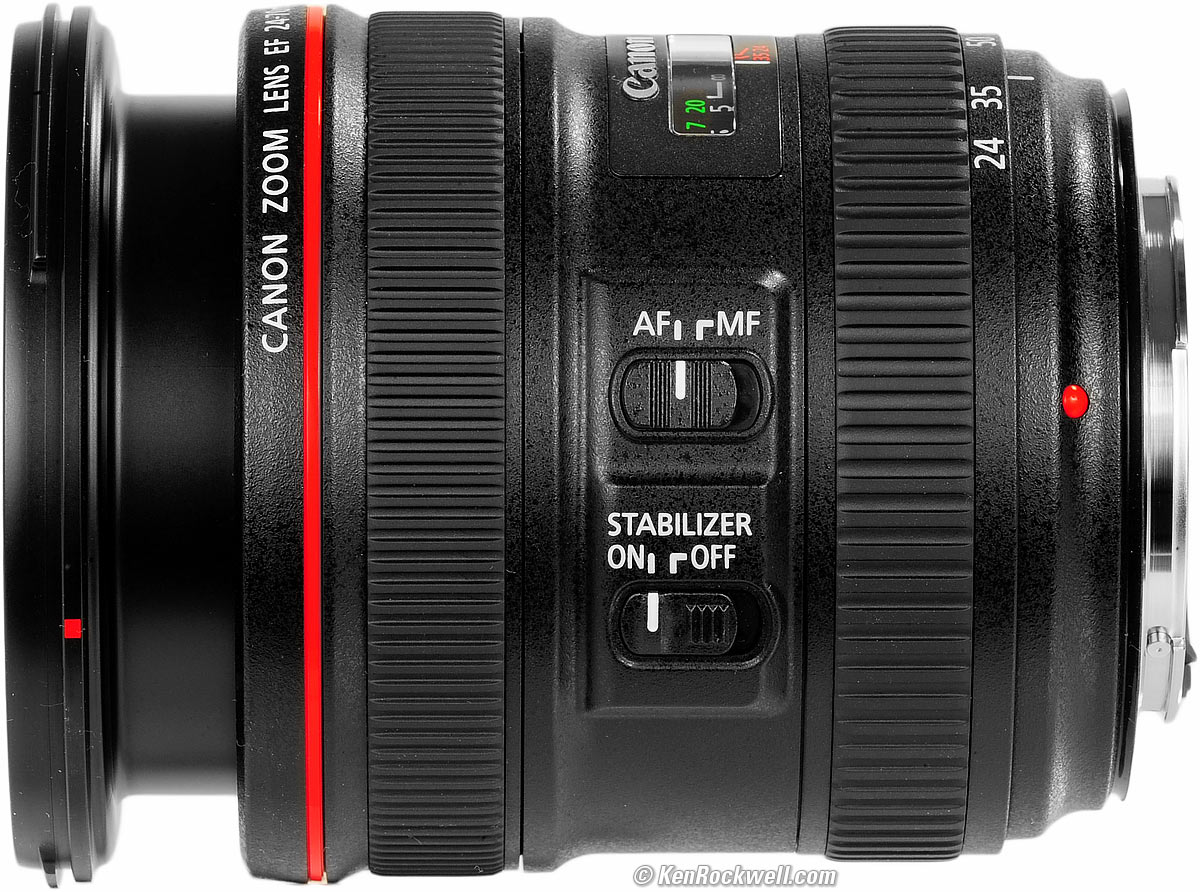Home Donate New Search Gallery Reviews How-To Books Links Workshops About Contact
Canon 24-70mm f/4 L IS
Full-Frame EF USM (2012-today)
Intro Compatibility Specs Performance
Compared Usage Recommendations
Canon EF 24-70mm f/4 L IS USM (77mm filter thread, 1.25 feet/0.38m close-focus, 8"/0.2m macro mode at 70mm, 21.2 oz./600g, about $899. enlarge. I got mine at Adorama. I'd also get it at Amazon or at B&H.
This all-content, junk-free website's biggest source of support is when you use those or any of these links to my personally-approved sources when you get anything, regardless of the country in which you live. Canon does not seal its boxes in any way, so never buy at retail or any other source not on my personally approved list since you'll have no way of knowing if you're missing accessories, getting a defective, damaged, returned, non-USA, store demo or used lens. Get yours only from the approved sources I use myself for the best prices, service, return policies and selection. Thanks for helping me help you! Ken.
April 2018 More Canon Reviews Canon Lenses All Reviews
24-70mm f/2.8 L II (2012-)
24-70mm f/2.8 L (2002-2012)
24-105mm f/4 IS L (2005-today)
24-85mm USM (1996-2006)
Sample Image Files
Interior, wide-open at f/4 at at 24mm, hand-held at 1/8 second 5D Mark III at ISO 100. bigger, full-resolution or Camera-original © 22 MP file.
Awning, wide-open at f/4 at at 24mm, hand-held at one-third of a second. 5D Mark III at ISO 800. bigger.
Palms at night, wide-open at f/4 at at 31mm, hand-held at one-half of a second. 5D Mark III at ISO 12,800. The dots? Stars. Fuzzy branches? Blowing in the wind while I got rock-solid tree trunks! bigger.
Frogs at dusk, wide-open at f/4 at at 31mm, hand-held at one-half of a second. 5D Mark III at ISO 400. Camera-original © 22 MP file (watch depth-of-field.)
If it can do this wide-open hand-held with long exposures, just imagine what it can do stopped down at reasonable speeds!
Introduction top
Intro Compatibility Specs Performance
Compared Usage Recommendations
|
|
This Canon 24-70mm f/4 L IS is a smaller, lighter version of the extraordinary professional 24-70mm f/2.8 L II. This 24-70/4 is as sharp for any practical purposes, which is extremely sharp at all settings, even wide-open, and has slightly less distortion.
This new lens also adds Image Stabilization to make up for its slower speed, which helps for still-lifes but does nothing for moving subjects. It also adds a fairly useless macro mode that gets down to nearly life-size, but requires you get so close that you can't light your subject.
Hee hee, macro modes were a popular kludge up through the 1990s and had been banished by about 2000, and now they're back again as a sales feature. Macro modes are good when they let us get extra close, but in practice they were and are a pain because we had to stop what we were doing and jack with them to get what we want. They went away when lens designers figured out how to get good macro performance at all settings, so we no longer needed the restrictive macro mode switches.
The good thing about this new 24-70/4 IS is that it already gets super-close (1.25'/0.38m, as close as the 24-70/2.8 L II) without needing any macro mode, and if you need to get even closer, you manually may turn the zoom ring past the 70mm mark to focus even closer.
It has instant manual-focus override: just grab the focus ring at any time.
Compatibility top
Intro Compatibility Specs Performance
Compared Usage Recommendations
This L lens is optimized for 35mm film and full-frame digital, and of course works on 1.3x and 1.6x Canon cameras.
This Canon EF EOS 24-70mm f/4 L IS works perfectly with every Canon EOS camera ever made, meaning every Canon DSLR and every Canon autofocus film camera made since 1987.
This means of course it works great on today's 5D Mark III, 6D and Canon 7D, but it works just as well on my original Canon EOS 650 from 1987!
As a full-frame lens, I am reviewing it as such for full-frame bodies.
Canon EF 24-70mm f/4 L IS USM. enlarge.
Specifications top
Intro Compatibility Specs Performance
Compared Usage Recommendations
Name
Canon calls this the CANON ZOOM LENS EF 24-70mm f/4 L IS USM.
EF means "electronic focus," meaning that there is an autofocus motor in the lens itself. All Canon lenses since 1987 have been EF.
L only means as expensive as L; it means nothing technically.
IS means twice as expensive as the first 24-70mm f/4 L.
USM means Ultra-Sonic Motor. This means autofocus is almost silent, and that you can grab the big focus ring for instant manual focus override at any time.
Optics top
15 elements in 12 groups.
Internal focus: nothing moves externally as autofocused.
Pumper zoom, grows as zoomed towards 70mm.
Two aspherical elements.
Two UD glass elements.
Multicoated, branded as "Optimized Super Spectra Coating."
Fluorine coatings on front and rear elements to help repel fingerprints.
Focal Length top
24~70mm.
On 1.3x Canon cameras it will see angles-of-view similar to what a 30~90mm lens would see on a 35mm camera.
On 1.6x Canon cameras it will see angles-of-view similar to what a 38~115mm lens would see on a 35mm camera, which is actually a very useful zoom range.
Angle of View (on 35mm and full-frame cameras)
84º - 34º diagonal.
53º - 19.5º vertical.
74º - 29º horizontal.
Close Focus top
1.25 feet (0.38m), specified, from the image plane, autofocus.
Separate manual-focus macro mode at 70mm gets to 7.9" (0.2m).
Maximum Reproduction Ratio top
Macro mode: 1:1.4 (0.7x).
Diaphragm top
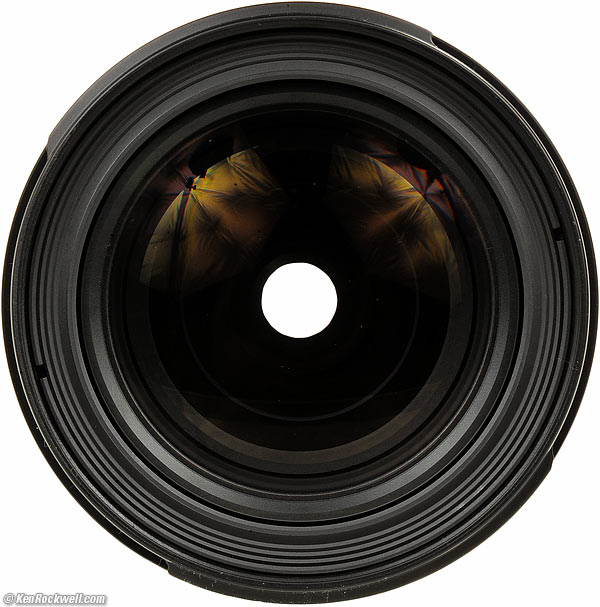
Front, Canon EF 24-70mm f/4 L IS USM at f/4 (EF diaphragm not visible).
9 rounded blades.
Hard Infinity Focus Stop? top
No.
You have to let the AF system focus for you at infinity.
Focus Scale top
Yes.
Depth-of-Field Scale top
No.
Infra-Red Focus Indices top
Yes, for 24mm and 35mm. Most likely for 800 nm.
Filter Thread top
77mm.
Does not rotate and doesn't move with focus, but does move in and out with zooming.
Size top
Canon specifies 3.3" (83.4mm) diameter by 3.7" (93mm) long.
It extends as zoomed to longer focal lengths.
Weight top
21.160 oz. (600.0g), measured.
Canon specifies 21.0 oz. (600g).
Hood top
Plastic bayonet reversible hood, included.
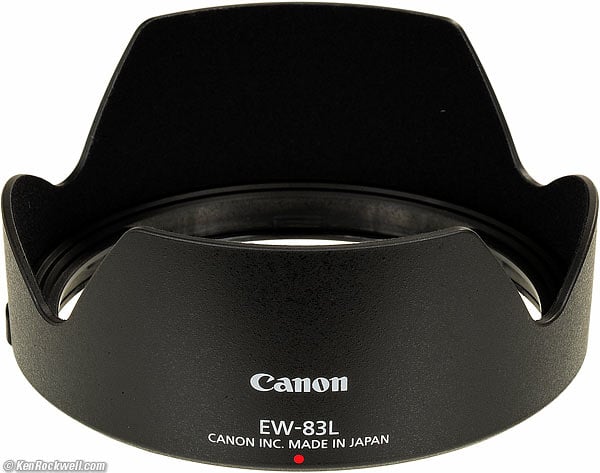
Canon EW-83L Hood.
Case top
$30 LP1219 sack, included.
Caps top
New 77mm E-77II front cap, included. It's a copy of Nikon's newest caps and much improved from Canon's previous caps.
Standard EOS cap rear, included.
Canon Model Number
6313B002.
Introduced top
06 November 2012.
Promised top
Promised for December 2012.
Shipping Since top
January 2013.
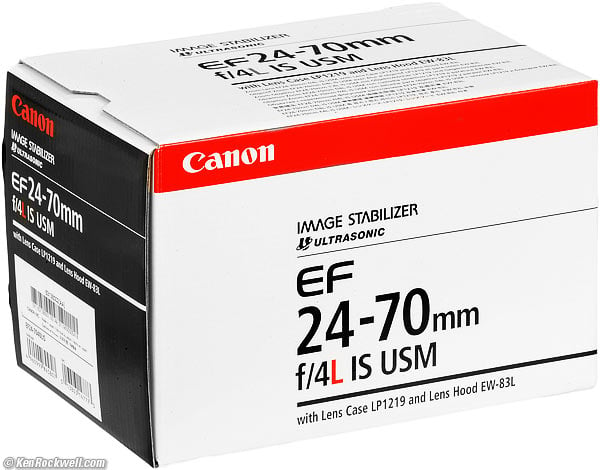
Box, Canon EF 24-70mm f/4 L IS USM.
Price, USA top
$899, April 2018.
$999 (only $799 after rebate), November 2014.
$1,500, November 2012.
Performance top
Intro Compatibility Specs Performance
Compared Usage Recommendations
Overall Autofocus Bokeh Breathing Color Coma
Distortion Ergonomics Eyeblow Falloff Filters
Flare & Ghosts Lateral Color Fringes Macro Mechanics
Sharpness Spherochromatism Sunstars
Overall performance top
The Canon 24-70 4 L IS is almost as sharp as the spectacular 24-70mm f/2.8 L II, but much smaller, about as well made, and adds Image Stabilization.
The "Macro" mode isn't very useful because the subject has to be so close to the lens that the lens blocks the light.
Autofocus performance top
Autofocus is fast and nearly silent, as we take for granted with Canon. For the still subjects I shoot, it's almost instantaneous.
Auto/Manual Switching
Just grab the focus ring at any time for instant manual-focus override.
Only move the AF-MF switch if you want to disable the camera from auto focusing.
AF Speed
AF is fast!, as Canons always are.
The AF motor hums very slightly if you're shooting in silence and you'll hear some internal sliding. This is essentially the same as every other modern AF lens.
AF Accuracy and Consistency
I saw no autofocus error on my Canon 5D Mark III.
Especially at f/4, every shot is dead-on at every focal length.
Yes! Perfection!
Focus with zooming
Focus shifts slightly as zoomed, so focus after zooming.
MACRO mode
Autofocus works in the MACRO mode, but it only works over a limited range.
Manual Focus
Manual focus is easy; just grab the ring.
It takes only 100º to go from end-to-end of the focus scale.
Bokeh performance top
Bokeh, the quality of out-of-focus areas as opposed to the degree of defocus, is usually neutral, especially for backgrounds when focused at close distances like 1 meter (3 feet). Sometimes you will get a bit of a dot in the middle of the blur circle, an artifact of the aspherical design.
Focused at 3 meters (10 feet), background bokeh at infinity starts to get worse, but so what; it's not far enough out of focus for it to matter.
If you want nice, soft backgrounds, shoot at f/4 at 70mm and get as close as you can to your subject.
Focus Breathing performance top
Focus breathing (the image changing size as focused) is mostly of interest to cinematographers who don't want the image changing size ("breathing") as the lens is focused among different subjects.
The image from the Canon 24-70mm f/4 L IS gets smaller as focused more closely, at all focal length settings.
Color Rendition performance top
The color balance of this 24-70mm f/4 L IS seems the same as my other Canon EF lenses.
Coma performance top
Coma, or saggital coma flare, is when points of light in the corners turn into batwing-shaped blobs. This is often a problem with fast normal or wide lenses.
I don't see any coma in this lens.
Distortion performance top
The Canon 24-70mm f/4 has mostly pincushion distortion. It has moderate barrel distortion at 24mm, and from 35-70mm it's got moderate pincushion distortion.
It has less distortion than either of the 24-70/2.8 L II or 24-70/2.8 L lenses.
Use these values in Photoshop's Lens Distortion tool to remove it:
On Full-Frame and 35mm |
3m (10') |
Infinity |
24-70/2.8 II at 3m (10') |
24mm |
+1.3* |
+2.0* |
+1.5* |
35mm |
-1.0 |
-0.2* |
0.0* |
42mm |
-1.8 |
-1.0 |
-1.7 |
50mm |
-1.6 |
-1.1 |
-3.0 |
70mm |
-1.7 |
-1.6 |
-2.7 |
© 2013 KenRockwell.com. All rights reserved.
* Some waviness remains.
Ergonomics performance top
Canon EF 24-70mm f/4 L IS USM. bigger.
Ergonomics are marvelous.
Zooming is smooth and never crowds any range together.It can be zoomed with one firm finger, and ideally wants two fingers for fast zooming.
The sample I bought certainly has no zoom creep, so I'm perplexed as to why it has a zoom lock. There is no bright fluorescent warning when you flip-on the zoom lock.
Manual focus feel is perfect.
Forget the Macro mode, it's a pain and gets so close you block your own light. I had hoped that locked-out macro modes that demanded a slide switch disappeared in the 1980s, but one returns in this lens as a sales feature.
The AF - MF switch falls right under your thumb.
The zoom and focus rings are made of rubber-covered alloy, which feels very solid.
Eyeblow performance top
As a "pumper" zoom that pumps in and out as zoomed, the air has to come and go somewhere.
Enough air pumps through the back of this lens that sometimes I can feel a little bit blowing on my eye as I zoom back to the wide end.
Yes, like many zooms, this lens pulls air through your camera and viewfinder.
Falloff (darkened corners) performance top
With a lens profile on my Canon 5D Mark III or similar camera, falloff is never visible at any setting.
On film or without a lens profiles, falloff is visible at f/4, and gone by f/5.6.
I've greatly exaggerated this by shooting a flat gray target and presenting it against a gray background.
Canon 24-70mm f/4 L falloff on full-frame 5D Mk III peripheral illumination control enabled, ISO 100:
© 2013 KenRockwell.com. All rights reserved.
5D Mk III peripheral illumination control disabled (same results on film):
© 2013 KenRockwell.com. All rights reserved.
|
Filters, Use with performance top
At 24mm on full-frame, only one filter works before we start getting vignetting.
On full-frame, a standard Hoya rotating polarizer (7.24mm ring thickness, excluding rear threads) works perfectly at every setting; there's no need for exotic thin filters.
If you need to stack filters, you'll have to zoom-in from 24mm.
On other than full-frame cameras, the crop factor ensures there will never be vignetting, even with stacked filters at 24mm.
Sadly, Canon cheaped-out and the filter threads are plastic, so be careful not to cross-thread.
Flare and Ghosts performance top
Full-frame, f/9 at 41mm. enlarge.
Flare and ghosts are very well controlled, but if you push it, you will get a green dot or two.
What dots you see where will vary with focal length setting and the position of the light source in your image.
Lateral Color Fringes performance top
Shot with a lens profile, there are no lateral color fringes.
Shot without a lens profile, there are slight yellow-violet fringes at 24mm, none at 35mm or 50mm, and very slight green-magenta fringes at 70mm.
Macro performance top
Here's how close we get on full-frame in the regular focus mode:
At regular close-focus distance at 70mm on full-frame, Canon 24-70 f/4 IS.
Here's a crop from this 22MP image at 100%:
Crop from above image at 100%, shot at f/8 at ISO 100 on a 5D Mark III. If this is 6" (15cm) wide on your screen, the full image would print at 40 x 60" (1 x 1.5 meters)!
The special MACRO mode is fairly useless because your subject can be closer than an inch to the front glass of the lens, making it impossible to light your subject. Here's how close it gets:
At closest MACRO mode distance on full-frame, Canon 24-70 f/4 IS.
See how my watch is in shadow? This is about the best I could do with the light streaming in from the side.
Here's a crop from this 22MP image at 100%:
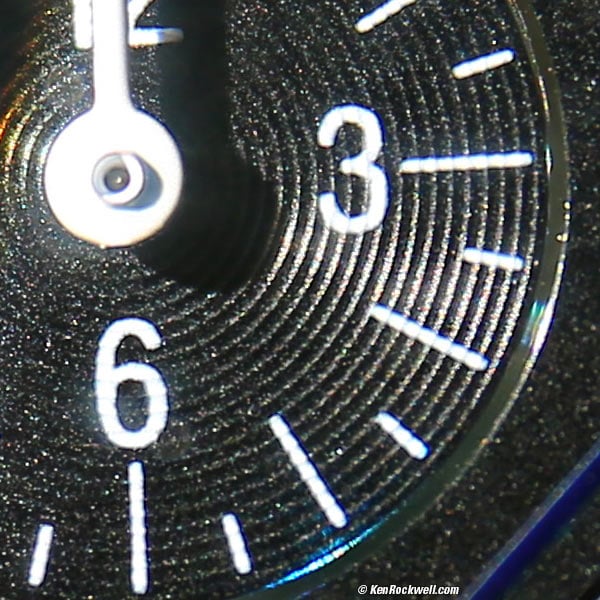
Crop from above image at 100%, shot at f/8 at ISO 100 on a 5D Mark III. If this is 6" (15cm) wide on your screen, the full image would print at 40 x 60" (1 x 1.5 meters)!
Autofocus works in the MACRO mode, but remember that it can't focus over much of a range, so you'll have to put the camera in about the right position before trying to autofocus. For macro, manual focus usually works better.
Nota bene: your EXIF data will read 80mm when the zoom ring is in the MACRO range.
Mechanics performance top
Rear, Canon EF 24-70mm f/4 L IS USM. enlarge.
The Canon 24-70mm f/4L IS is made very well, but mostly out of plastic on the outside.
The front section of this new lens is all plastic, and if you try to wiggle it when extended, a very little bit of wiggle is normal.
Filter Threads
Plastic.
Fore Barrel
Plastic.
Hood Mount
Plastic.
Identity Ring
Plastic.
Focus Ring
Metal, rubber-covered.
Mid-barrel
Plastic.
Internals
Metal and plastic.
Zoom Ring
Metal, rubber-covered.
Rear barrel
Plastic.
Moisture seal at mount
Yes.
Mount
Chromed metal.
Markings
Paint.
Serial Number
Laser engraved into the bottom of the plastic lens barrel.
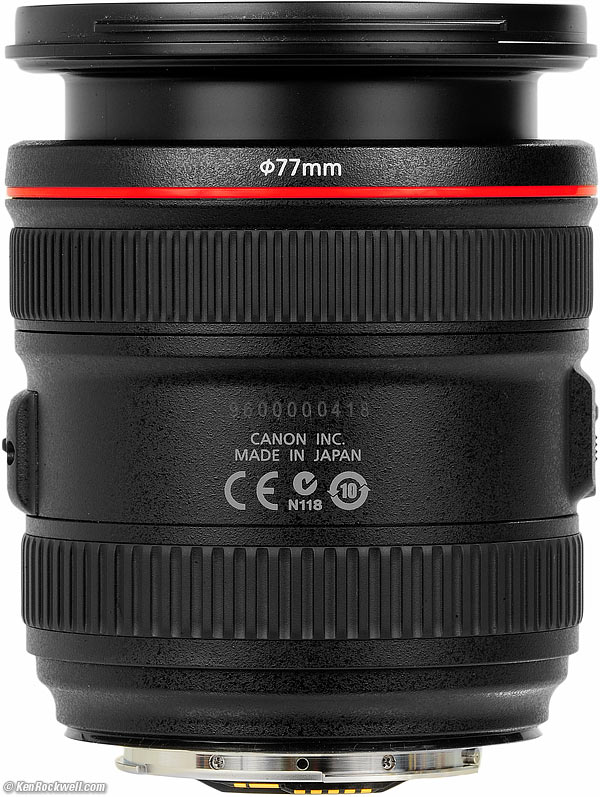
Bottom, Canon 24-70 4 IS.
Date Code
None found.
Noises When Shaken
Moderate clunking and clattering.
Made in
Japan.
Sharpness performance top
This said, the Canon 24-70mm f/4 L is excellent. Its sharpness varies very little from center to edge and stays about the same with aperture. There isn't much reason to stop down for more sharpness; it's already super-sharp at f/4 all the way to the corners.
So long as you're in focus, sharpness doesn't vary much from perfection, except by f/11, where diffraction softens the image.
Hey, sorry to spare you endless boring charts, but with a lens this good, there's nothing to show other than sharp pictures under all conditions.
The biggest detriment to sharpness will be a lack of proper vision and technique, never this lens. I bought mine directly from Adorama. I can't vouch for anything if you buy from a local store or chain where you never really know who's opened and played with your lens before you buy it. I never buy retail; too many risks, so why pay more?
Here are Canon's claimed MTF curves, which agree with what I see:
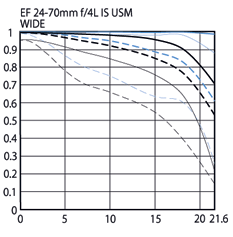 |
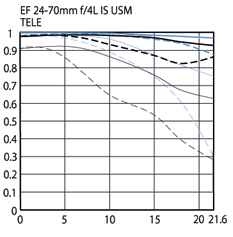 |
Canon's MTF Curves.
Compared to the 24-70/2.8 L II, the MTF curves suggest that this f/4 lens is a little bit less sharp, and that agrees with what I see. The differences is negligible.
Spherochromatism performance top
I see no spherochromatism.
Sunstars performance top
Full-frame, f/16 at 45mm. enlarge.
With its 9-bladed diaphragm, this Canon 24-70mm f/4 L IS can make 18-pointed sunstars on brilliant points of light.
I'm very pleasantly surprised: even though Canon claims "rounded," which usually kills any sunstars, I see sunstars at moderate and smaller apertures under the right conditions. They tend not to be that obvious (this is an unusually clear example), and they aren't that symmetrical.
Sunstars help an image tell the viewer just how bright the points of light are, since a photo can't otherwise reproduce the effect of a light or brilliant reflection shined in your face.
I'm really excited about the sunstars. They usually have sharp points, not the soft muted ones of today's wimpy "rounded" diaphragms, and they can be seen at normal apertures like f/8 and f/11, not needing to squint at f/22.
Hooray!
Compared top
Intro Compatibility Specs Performance
Compared Usage Recommendations
NEW: All 24-70mm Lenses Compared.
This 24-70/4 is much smaller and lighter than the 24-70/2.8 L and 24-70/2.8 L II, and adds IS. They are all extremely sharp, with the 24-70/2.8 L II having a slight edge if you're splitting pixels.
This 24-70/4 is a little bit smaller and lighter than the 24-105/4 L IS, and has greatly improved ability to zoom well at the widest end. My peeves about the 24-105L are its cramped zoom between 24 and 35mm, that the 24-105mm has extremely strong distortion at 24mm, and that the 24-105 has an idiotic 8-bladed diaphragm. This 24-70mm fixes all three of these problems, but you lose the 70mm to 105mm end of the zoom.
See my Midrange Zoom Comparison for much more.
Usage top
Intro Compatibility Specs Performance
Compared Usage Recommendations
Side, Canon EF 24-70mm f/4 L IS USM. enlarge.
AF - MF switch
Leave this at AF.
The MF setting locks it into manual focus only.
In AF, just grab the ring for manual focus override.
Stabilizer
Leave this at ON, even if on a monopod or many tripods.
Turn it OFF only if on a very sturdy tripod, or for long time exposures.
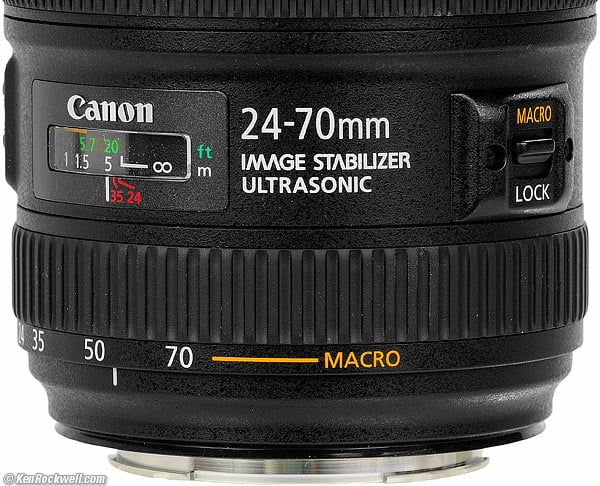
Macro Controls, Canon EF 24-70mm f/4 L IS USM.
MACRO and LOCK switch
Leave this in the middle.
If you set the lens to 24mm and slide it to LOCK, it locks the lens at 24mm. My lens doesn't creep, and even if it did, I'd rather turn the zoom to get it back to 24mm than have to fiddle with unlocking this switch to be able to zoom again.
To move the ring into the MACRO mode, push and hold the switch toward MACRO while rotating the ring to the MACRO range.
To return to the usual zoom range, push and hold the switch toward MACRO while rotating the zoom ring to the usual zoom range.
To focus in the MACRO range, turn the zoom ring and move the camera for coarse adjustments. Use the Focus ring for fine-tuning. For optimum results, Canon suggests leaving the focus ring at about the orange band at the 1 meter setting.
Recommendations top
Intro Compatibility Specs Performance
Compared Usage Recommendations
This 24-70mm f/4 L IS is a great lens: super-sharp, reasonable distortion with Image Stabilization and great handling.
The original $1,500 price was excessive in 2012, but has become appropriate at $999 (or $799 with a rebate) in 2014.
Versus the flagship 24-70mm f/2.8 L II, the difference is obvious. This f/4 IS lens is more portable and ideal for still lifes, but if the subject is moving, IS is of no help and the extra stop makes the f/2.8 lens twice as useful in low light or with live subjects.
For most people on full frame, the 24mm end means you don't need another wide lens like the 16-35mm II. Since I do need the ultrawide end and carry an ultrawide anyway, I'd rather this lens covered 35-105mm instead.
This 24-70 is also ideal on smaller-format cameras, offering what I find to be an even handier effective focal length range (30-90mm on 1.3x and 38-115mm on 1.6x).
Ignore the macro mode; you have to get so close that you'll block your light. If you want real macro, get the superb Canon 100mm f/2.8 Macro or Tokina 100mm f/2.8 for better performance at one-third the price.
I'd use a 77mm B+W 010 MRC UV filter for protection, or a Canon 77mm UV, or a 77mm Hoya UV. These filters are all very good; the reason to pay more for the B+W is simply if you feel better with a $70 rather than a $43 filter on a $1,500 lens.
I got mine at Adorama. I'd also get it at Amazon or at B&H.
If you've found the effort I've spent in sharing this professional review helpful, this free website's biggest source of support is when you use those or any of these links when you get anything, regardless of the country in which you live.
Thanks!
Ken.
© Ken Rockwell. All rights reserved. Tous droits réservés. Alle Rechte vorbehalten.
Help Me Help You
I support my growing family through this website, as crazy as it might seem.
The biggest help is when you use any of these links when you get anything. It costs you nothing, and is this site's, and thus my family's, biggest source of support. These places always have the best prices and service, which is why I've used them since before this website existed. I recommend them all personally.
If you find this page as helpful as a book you might have had to buy or a workshop you may have had to take, feel free to help me continue helping everyone.
If you've gotten your gear through one of my links or helped otherwise, you're family. It's great people like you who allow me to keep adding to this site full-time. Thanks!
If you haven't helped yet, please do, and consider helping me with a gift of $5.00.
As this page is copyrighted and formally registered, it is unlawful to make copies, especially in the form of printouts for personal use. If you wish to make a printout for personal use, you are granted one-time permission only if you PayPal me $5.00 per printout or part thereof. Thank you!
Thanks for reading!
Mr. & Mrs. Ken Rockwell, Ryan and Katie.
